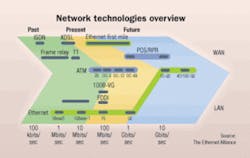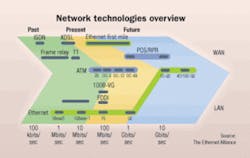It’s the end of Category 5e, and with Category 6 under fire, long live Category 6A.
As with most new technologies, the networking industry has jumped on the latest: 10-Gigabit Ethernet over copper cabling. While many seem to be saying, “I’ll never need 10 Gbits/sec to the desktop,” beware of the future and learn from the past.
Not long ago, the hot topic was Gigabit Ethernet development to the desktop. In cabling terms, this fast technology accelerated the trend toward Category 5e and Category 6 cabling. Tri-speed 10/100/1000 Ethernet interface cards let network managers leverage their existing investments. With the reducing costs of these interface cards, Gigabit Ethernet is growing dramatically.
With the inevitable drive to gigabit-speed networking and beyond, transmission technology pushed Category 5e cabling to its limit, signaling the end of Category 5 cabling as we have known it. Category 6 appeared as the savior, allowing users to specify a cabling system with enough performance for robust and reliable gigabit transmission. But as the market continues to move and advance up the technology ladder, 10-Gbit/sec over copper cabling has been the most recent and active challenge for cabling and networking developers. It has now arrived in the form of the IEEE 802.3an 10GBase-T specification.
Eagerly awaited by IT managers worldwide, the ratification of 10GBase-T, and the subsequent publication of new cabling standards to follow, will accelerate the migration to highly reliable 10-GbE-capable just as the move to Gigabit Ethernet showed over the past few years.
The new standard requires copper cabling channels with twice the bandwidth offered by Category 6 cabling, and five times that of Category 5e, and opens the way for high-quality combined video, voice, and data communication up to 100 meters over twisted-pair cabling. To ensure a robust cabling specification supporting 10GBase-T, the standards in development for Category 6A/Class EA cabling offer levels of performance that exceed the requirements of the new IEEE standard. Using the new standards, network managers can build 10-GbE network infrastructures confident that they are investing in technology that has sufficient performance and conforms to specifications accepted worldwide.
10-GbE standards simply stated
The development of the initial 10-Gbit Ethernet standard was undertaken by the IEEE 802.3ae Committee and was based primarily on fiber-optic technology. Four optical transceivers were selected: 10GBase-LR-1310-nm serial for singlemode fiber; 10GBase-ER-1550-nm serial for singlemode fiber; 10GBase-SR-850-nm serial for laser-optimized multimode fiber (referred to as OM3 fiber in international standards); and 10GBase-LX4-1310-nm wide wavelength division multiplexing (WWDM) for installed multimode fiber and singlemode fiber.
10-Gbit Ethernet technology has continued to evolve, with accelerating adoption in growing segments of the computing market. Blade servers, networked enterprise switches, video servers, and other applications can now benefit from 10-GbE speeds in storage, system backup, teleconferencing, and surveillance systems. Technical advances have enabled the higher density, reduced power, and cost-effectiveness needed to attract all of the major system developers. The ratification of 10GBase-T is expected to accelerate this market acceptance and adoption.
High-speed standard development
While the published 10GBase-T standard includes the necessary transmission requirements, there is some confusion regarding the cabling options. Because the transmission requirements in the 10GBase-T standard exceed those specified for Category 6/Class E, 10GBase-T will only achieve limited distances over Category 6/Class E UTP cabling.
Cabling standards bodies are developing informative documents for the installed base of Category 6/Class E or higher performance cabling (TSB-155 by EIA/TIA and TR24750 by ISO/IEC) that are intended to provide guidelines to verify support for 10GBase-T. These guidelines will include a number of mitigation procedures that range from unbundling of cables to replacement of various components to minimize crosstalk from adjacent channels and improve high-frequency performance. A maximum distance of 37 meters may be achievable in some cases and may require mitigation steps. In anticipation of this limitation, cabling standards bodies have been rapidly developing new Category 6A/Class EA specifications that will guarantee 100-meter support for new installations.
The 10GBase-T standard already refers to the Category 6A/Class EA channel specifications, since they are already mature and are unlikely to undergo significant changes before publication (expected later this year or early 2007). With the announcement of the completed IEEE 10GBase-T standard and the upcoming Category 6A/Class EA standards, end-user customers have assurance that a Class EA cabling plant has a networking standard finalized and ratified that takes full advantage of its performance.
While cabling categories only provide the minimum requirements for LAN network design, Category 6A/Class EA raises that minimum standard at a critical time for the enterprise market. Networks are deluged by heavier traffic, including e-mails with ever-larger attachments and more complex desktop applications. In addition, multimedia applications, such as video streaming, will all but cripple slower, last-generation networks.
Today’s companies need to plan for tomorrow and they need more bandwidth-the capacity to send large volumes of information quickly. They also need greater throughput-the capability to send all the information successfully the first time. When the company network has to be up and running 24/7, there is great comfort in knowing that a better infrastructure based on Category 6A/Class EA has been deployed.
Looking ahead
Industry analysts predict that 10-Gbit/sec networks will be a growth area for network equipment vendors in the next 5 to 10 years. As was previously seen with Gigabit Ethernet, the acceptance of new cabling types in the market was held back by the lack of a published IEEE standard to take advantage of them. The ratification of IEEE 802.3an 10GBase-T now provides the level of confidence many organizations are waiting for in order to move up from Category 5e and 6 specifications and begin deployment of Class EA-compliant cabling.
Category 6A/Class EA delivers improved cabling specifications to handle the impending move to 10-GbE communications as the impact of the IEEE 802.3an ratification takes hold. Now is the right time to re-evaluate your network’s long-term capabilities. I have no doubt that 10-Gigabit speeds to the desktop will eventually become a reality due to steadily increasing bandwidth demands, coupled with the reducing cost of interface electronics. It may not be tomorrow, but certainly in the lifetime of your cabling infrastructure.
End users must be aware that different cabling standards exist and bring with them different levels of capability. Vendors will claim to “meet the standards,” but end users should ask, “Which one?” and fully understand the required response. My recommendation for a simple and clean approach is to refer to the current ISO/IEC Class EA specification, as it is more stringent than the others, and compliance to this global specification offers peace of mind that all requirements are covered.
Still, any prediction about future bandwidth requirements to the desk could be just as accurate as Bill Gates’ now-infamous prediction that “64K of RAM should be enough for everyone.” One thing, however, is certain: Within the 10- to 20-year lifespan expected of a structured cabling system, PC and networking technology will change dramatically.
The relentless pace of PC developments following Moore’s Law (processor capacity doubling every 18 months, or the equivalent of adding a 0 every 5 years), coupled with the implementation of new PC bus technologies, larger storage capacity, and faster memory chips, point to continued increases in bandwidth capabilities at the desk.
As for the applications that will require this additional bandwidth, a review of the increase in e-mail traffic and attachment sizes suggests that it will not just be future applications (such as 3D visualization, high-definition video, or others not yet considered) that will require gigabits to the desk. When the traffic peaks from file transfers, e-mail attachments, streaming video, unified messaging, and other commonly deployed applications can combine to tax the capability of today’s LANs, 10-GbE networking is an attractive possibility.
One- and 10-GbE connections are already being deployed in niche industries with intensive graphics, video, storage, or data manipulation requirements, but the current price of 10-GbE optical network interface cards is beyond the reach of the average user. Market-driven price decreases, coupled with the expanding installed base of Category 6A/Class EA cabling and the introduction of 10GBase-T electronics, are likely to accelerate the affordability of 10-GbE electronics in the next few years, unleashing additional bandwidth capacity.
The only prediction that can confidently be made about bandwidth demands or new network-centric applications, beyond the five-year horizon, is that they are unpredictable. Such unpredictability is the basis for the most powerful argument in favor of a large surplus in the capacity of any new cabling installation. Category 6A/Class EA cabling offers not only the ability to migrate to more cost-effective 10-Gigabits to the desk, but also improvements in throughput for today’s applications.
The debate over the need for Category 6A/Class EA cabling has a number of parallels with the debate over the need for Category 5e cabling that took place more than 10 years ago, when some experts claimed that there was no need for Category 5e cabling. With Category 5e and 6 performance specifications being pushed to their limits by existing technologies, Category 6A/Class EA is already taking over for new installations.
History will repeat itself. Will you deploy 10-Gigabit Ethernet to the desktop? Time will tell, so limiting your options today due to your cabling choices may prove costly in the end.LUC ADRIAENSSENS is senior vice president, R&D and technology enterprise, for Systimax Solutions (www.systimax.com).
Systimax Labs' role in standards creation
Systimax Labs has been instrumental in contributing technical expertise to finalize the latest IEEE standard, and also the proposed TIA/EIA and ISO/IEC cabling standards. For a decade, the Systimax research-and-development team has developed many of the products and solutions that were the precursors to cabling standards.
The company’s Category 6A/Class EA system, GigaSpeed X10D, is the result of what is called the Systimax Labs Effect. Through the use of proprietary design tools, such as modal decomposition modeling, the company’s engineers and scientists use a top-down systems approach to design LAN cabling channels. Every cabling component is optimized for individual as well as peak system performance.
Systimax scientists and engineers are active participants in every major standards-setting organization in the world, and remain at the forefront of new standards development. The company’s technological leadership has led to improvements in cabling standards and has benefited the industry through standards-based network architecture.
While cabling standards have improved over the years, they are just minimum requirements. Superior quality coupled with performance margin and headroom are the sure edge companies should have to successfully compete and succeed in an unsure future.-LA


